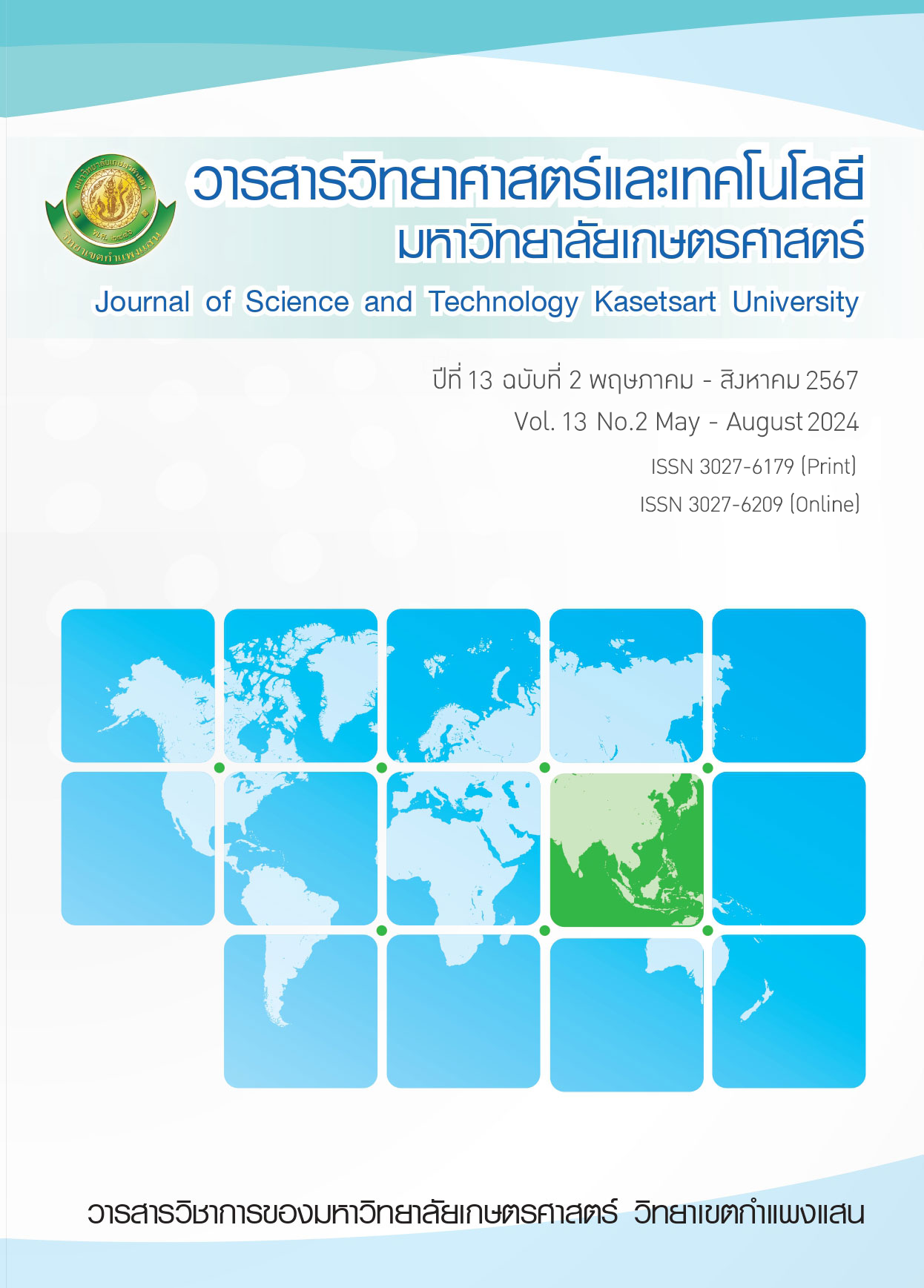Effect of Wheat Flour Substitution with Sweet Cassava (Manihot esculenta (L.) Crantz) (Hanatee variety) Flour on The Characteristics of Cracker
Main Article Content
Abstract
This research was aimed at investigating the effect of wheat flour substitution with sweet cassava (Manihot esculenta (L.) Crantz) (Hanatee variety) flour on the development of cassava crackers. The substitution of cassava flour at the levels of 0, 20, 40, 60, 80 and 100% by weight of wheat flour was carried out. The result was found that the basic formula of cracker was formula 3. The ingredients were included wheat flour (52.20%), water (1.20%), butter (27%), salt (0.60%) and icing sugar (19%) (Prachsanee et al., 2565), which had the highest acceptance score in terms of appearance, color, odor, taste, texture and overall liking (p≤0.05). An increase in the amount of cassava flour resulted in a reduction in color values reflected by L*, whereas the values of a* and b* significantly increased (p≤0.05). The moisture content and water activity (aw) of cassava crackers tended to increase as the amount of cassava flour increased. The texture characteristic in terms of hardness was decreased, whereas the cassava increased (p≤0.05). Moreover, the sensory evaluation test found that the cracker using 60% cassava flour (by weight of wheat flour) had the highest acceptance score in terms of appearance, color, odor, taste, texture, and overall liking: 8.53, 8.63, 8.53, 8.57, 8.60 and 8.73, respectively. The nutritional value of cracker using 60% cassava had the ash, carbohydrate and dietary fiber higher than the control cracker (100% wheat flour) (p≤0.05).
Article Details
References
เบญจพร มีเกาะ, หทัยรัตน์ ริมคีรี, เพ็ญขวัญ ชมปรีดา และสุมนรัตน์ ชื่นพุฒิ. (2546). การใช้ฟลาวมันสำปะหลังทดแทนแป้งสาลีในพายกรอบ การประชุมทางวิชาการของมหาวิทยาลัยเกษตรศาสตร์ ครั้งที่ 41: สาขาอุตสาหกรรมเกษตร (น. 230-235). กรุงเทพฯ:มหาวิทยาลัยเกษตรศาสตร์.
กรมเจรจาการค้าระหว่างประเทศ. (2564). ส่งออกสินค้าเบเกอรี่ บิสกิต และเวเฟอร์ ของไทยเติบโตต่อเนื่อง. เมื่อ 10 มกราคม 2566, จาก https://www.dtn.go.th/th/content/category/detail/id/982/iid/3313.
ญาณิศา โพธิ์รัตน์โส. (2562). การพัฒนาผลิตภัณฑ์แครกเกอร์ฟักทองปลอดกลูเตน. (วิทยานิพนธ์ปริญญาบัณฑิต). มหาสารคาม: มหาวิทยาลัยราชภัฏมหาสารคาม .
ธนชัย จิวะวรเกียรติ, ปัทมา ปานเจริญ, พรรณผกานาคะโว, มนชนก ตระกูลทา และอาภัสรา แสงนาค. (2564). ผลของสตาร์ชมันสำปะหลังแบบพรีเจลาทิไนซ์ และคาร์บอกซีเมทิลเซลลูโลสต่อคุณภาพของแครกเกอร์ที่ทำจากข้าวกล้องงอก. วารสารวิทยาศาสตร์และเทคโนโลยี มหาวิทยาลัยราชภัฎยะลา, 6(1), 27-36.
ธิดารัตน์ แสนพรม. (2565). ผลของปริมาณงาขี้ม้อนต่อคุณสมบัติทางกายภาพทางประสาทสัมผัส และคุณค่าทางโภชนาการของเค้กฟลาวมันสำปะหลังด้วยการใช้ไมโครเวฟในการอบ. วารสารมหาวิทยาลัยคริสเตียน, 28(4), 88-99.
ปรัศนีย์ กองวงค์, ศิริลักษณ์ พวกกล้ากุล, และอรทัย บุญทะวงศ์. (2565). การศึกษาคุณภาพของแครกเกอร์เสริมเส้นใยอาหารจากแกนสับปะรด. วารสารวิจัยวิทยาศาสตร์และเทคโนโลยี นครราชศรีมา, 71(1), น. 65-73.
ปรียนุช โตเจริญ. (2552). Easy Cookies. กรุงเทพฯ: อมรินทร์.
พัชรินทร์ เพชรมาก, เพ็ญขวัญ ชมปรีดา, วิชัย หฤทัยธนาสันติ์, กล้าณรงค์ ศรีรอต และชื่นจิตต์ แจ้งเจนกิจ. (2547). การพัฒนาผลิตภัณฑ์บัตเตอร์เค้กลดพลังงานจากฟลาวมันสำปะหลังพันธุ์เกษตรศาสตร์-50. การประชุมทางวิชาการของมหาวิทยาลัยเกษตรศาสตร์ ครั้งที่ 42: สาขาประมง สาขาอุตสาหกรรมเกษตร (น. 582-589). กรุงเทพฯ:มหาวิทยาลัยเกษตรศาสตร์.
พัชรินทร์ เพชรมาก. (2547). การพัฒนาผลิตภัณฑ์บัตเตอร์เค้กลดพลังงานจากฟลาวมันสำปะหลังพันธุ์เกษตรศาสตร์- 50. (วิทยานิพนธ์มหาบัณฑิต). กรุงเทพฯ: มหาวิทยาลัยเกษตรศาสตร์.
ศิริลดา ศรีกอก. (2564). การใช้แป้งพรีเจลาติไนซ์เมล็ดขนุนทดแทนแป้งสาลีในผลิตภัณฑ์แครกเกอร์. วารสารวิทยาศาสตร์และเทคโนโลยี (สทวท.), 8(2), 22-42.
สำนักงานมาตรฐานผลิตภัณฑ์อุตสาหกรรม. (2555). มาตรฐานผลิตภัณฑ์ชุมชนขนมปังกรอบ มผช 523/2555. กรุงเทพฯ : สำนักงานมาตรฐานผลิตภัณฑ์ชุมชน.
สุทธิสา ดัชนีย์. (2022). ฟลาวมันสำปะหลัง. การประชุมวิชาการประจำปี สวทช. ครั้งที่ 17. กรุงเทพฯ: สำนักงานพัฒนาวิทยาศาสตร์และเทคโนโลยีแห่งชาติ (สวทช.).
AOAC. 2019. Official methods of analysis of the association of official analytical chemists: official methods of analysis of AOAC international. (21 Ed), Washington DC : AOAC.
Klunklin, W., and Savage, G. (2018). "Biscuits: A substitution of wheat flour with purple rice flour. International Journal of Food Science and Technology. 2(3), 81-97. doi: 10.22606/ afse.2018.23001.
Ocheme, O.B., and Adedeji, O.E. (2018). Proximate composition, functional, and pasting properties of wheat and groundnut protein concentrate flour blends. Food Science and Nutrition. 6(5), 1173-1178. doi: 10.1002/fsn3.670.
Pizzinatto, A., and Hoseney, A.C. (1980). Rheology change in cracker sponges during fermentation. Cereal Chemistry. 57(3), 185-188.
Puechkamut, Y., and Phewnim, W. (2011). Quality improvement of sandwich bread substituted wheat flour with soy milk residue. The Journal of KMUTNB, 21(3), 607-616.
Ruechakul, W., Punsawat, N., and Maneeroch, J. (2014). Effect of rice bran oil, baking temperature and time on the quality of salmon crackers from salmon trimming. 52nd Kasetsart University Annual Conference. Bangkok: Kasetsart University.


